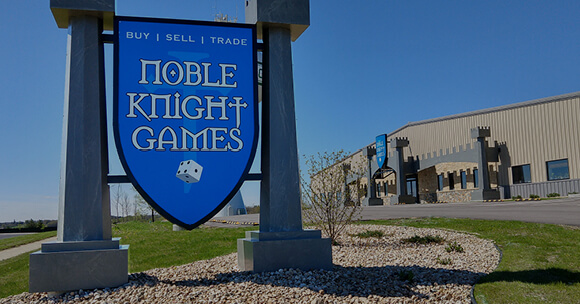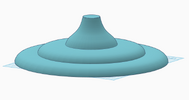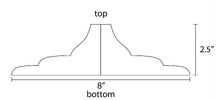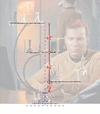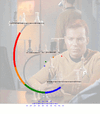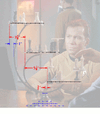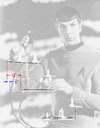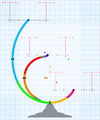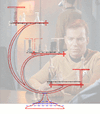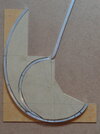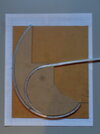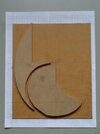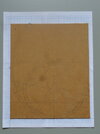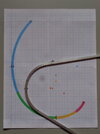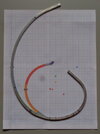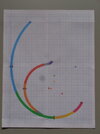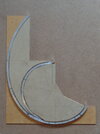I'm coming a bit late to this thread, but I may have some helpful information. Some years ago, we did a fairly exhaustive analysis of the original Chess Prop on another forum, one which has since gone dark and all of its content lost. (Don't ever think "the internet is forever," cuz it sure ain't.) I can't reconjure the full discussion thread and all its details, but I'll try to summarize key findings, with a few images I happen to have saved.
We started with measurements of existing "found items" matching the screen-used prop: Pleasantime Space Checkers, Checkline Tic-Tac-Toe, and both Ganine Classic and Ganine Gothic chess piece sets. We could then accurately scale and take additional measurement estimates from copious episode framegrabs and as many publicity photos as we could find, some of which showed previously-mysterious details in surprising clarity.
The original Chess Prop was thrown together in a rush for the second pilot, and manhandled over the years. It mostly sported four small boards, but premiered with five, and showed up once with six. The horizontal positions of its main boards never aligned its squares above-and-below each other on its best days, and its main boards were often shown turned at odd angles as well. Its outer curved arm was bent at a very different angle in later episodes versus early episodes. And the vertical spacing of its boards was never sufficient for its chess pieces.
Raw materials:
- The chess pieces used in Where No Man were never reused, and were likely somebody's personal set, apparently handcarved and quite tall. The chess pieces used throughout all three seasons alternated between Ganine Classic and Ganine Gothic.
- The main boards from the Checkline game are 8"x8", with effectively 2" squares. They are molded completely clear, flat on their underside, and with slightly raised lines separating their squares on their topside to more easily hold their tokens during play. Their pins are centered about 3/8" inset from their edges and molded hollow, squared and open above, rounded and closed below.
- The Checkline game comes with 3" vertical spacers to hold its boards apart. Early production runs used clear tubes. Later runs used opaque tubes or solid struts with tubelike ends.
- The small boards from the Pleasantime game are 3"x3", with effective 1-1/2" squares. They are molded with clear plastic but have a fine pebbly texture on the tops of two of its four squares, making them appear whitish. They also have a "split collar" underneath the center of each board, to friction-fit onto the Pleasantime vertical spacer tubes. Later production runs used all red boards.
- The Checkline spacer tubes and Pleasantime spacer tubes are not compatible. The Pleasantime tubes have both a thicker outer diameter than the Checkline tubes, and a smaller inner diameter than the Checkline tubes, so they won't fit onto the Checkline pins.
- The Chess Prop's curved arms appear to made from 3/8" square solid rod stock, most likely aluminum. We believe the curved arms were not a found item, but bent and cut just for this prop.
- The Chess Prop's base is about 9" in diameter, and about 3" tall. We believe it was a found item of the day, maybe a globe base, a plant stand, a lamp base, a chandelier ceiling mount, or something else, but we never found an exact match for it.
Assembled into the Chess Prop:
- The Chess Prop painted its main Checkline boards' alternating squares red, between its raised lines, with a transparent red paint. One square of each board has a Checkline logo molded into it; on The Chess Prop, those logo squares are painted red.
- The Chess Prop mounted its main Checkline boards by drilling a hole through the center of the board and using a single screw to attach it to its arm. Our best guess is a #8 slotted pan head sheet metal screw.
- The Chess Prop mounted its main Checkline boards upside-down, to place its raised lines on the underside and leave the topside smooth. The pins are another tell (round end up), and the inverted (painted) logo is also visible in one Charlie X shot.
- The Chess Prop did not need to paint its small Pleasantime boards, as they came already molded with textured alternating squares.
- The Pleasantime tubes don't fit onto the pins of the main Checkline boards. The Chess Prop used the 3" Checkline clear tubes to hold up its smaller boards, with a bit of clear tape around the top of each tube to give the small Pleasantime boards a snug fit.
- The apparently complex shape of each curved arm seems to be a collection of piecewise circular arcs. We believe square rod stock was manually shaped with a three-roller bender.
- At each point where a board is attached to a curved arm, the arm flares out to better support the board, with a hole drilled through it to take the screw holding the board. We were unable to determine how these flares were made, but the drilled hole is visible from beneath in some images.
- The two curved arms are attached to one another with two sets of nuts and bolts. Our best guess is 1/4" slotted round head machine bolts and matching 1/4" hex nuts.
- The join of the outer curved arm to the base appears seamless. Rather than being welded, our guess is that the outer arm was drilled into and tapped, and a bolt threaded into it through the base from below.
Some replica fabrication tips:
- Ganine Classic (honeydripper) chess piece sets are almost impossible to find these days, but Ganine Gothic (face) sets are still readily and affordably available on eBay, and are equally screen-accurate. Make sure you get the Salon (standard) size, with a 3-3/8" King, and not the Tournament (taller) size with a 4-1/2" King that shows up occasionally.
- Exactly how screen-accurate do you want to be? Ganine 3-3/8" Kings won't fit under the small boards if you use 3" spacers. I wanted my prop to be fully playable, so before bending my support arms I drew up "idealized" plans that adjusted all vertical spacing to ensure my Ganine King would fit everywhere, with my main boards 7" apart and the small boards in the middle at 3-1/2". This required using 3-1/2" spacers. I used the thicker Pleasantime tubes and carefully widened their bottom openings to fit the Checkline pins, delicate work and easy to screw up.
- Some replicas further adjust the horizontal positions of their main boards to align their squares vertically above/below each other. I chose to keep my horizontal positions "jaunty".
- Note that even with the main boards' pin centers being inset 3/8" from the edges, the 1-1/2" squares on the small boards means they don't overhang further than a single 2" square on the main board. Many replicas don't get this right, using 2" squares throughout, leading to different overall proportions and a somewhat crowded look to its small boards.
- Each curved arm is not single circular arc! Replicas that do this produce an outer arm that swings out well beyond the top main board, making the whole prop want to tip over easily unless you put extra weight in the base.
- Whatever you decide for your board positions or curved arm shapes, draw up your plans and print them at 1:1 scale to use as a target reference when bending up your rod stock for your arms.
- To paint the red squares on the main boards, we experimented with many different paints and found Testor's "Candy Apple Transparent Red" to work well. Masking-tape the hell out of the rest of your board, give it one or two gentle coats, then peel the tape and you should be good.
- To paint the squares on your small boards, you might want to experiment with something that would make a clear pebbly texture, or try a "frosted" craft paint.
- To bend aluminum square rod stock into the desired shapes, we've had good success with the same process using a manual three-roller bender, tweaking the shape until it was close enough to our target then cutting the ends.
- Before making the final cut of my inner curved arm, I added one final "upward" bend right at the cut point, rather than grinding it down after cutting. I didn't do this with the bender, but just heated up the spot until I could bend it by hand. But I did make a wooden rig to hold the curved arms while I made the final cuts, to ensure they stayed square.
- To make the flares where the arms support the boards, some replica makers have spoken with professional welders. I made mine by using thick fender washers, and attaching them to the already-bent-and-cut arms with two-part aluminum putty/epoxy like J-B Weld.
- For your base, some replica makers have had them lathed out of solid aluminum. I made mine with a 9" aluminum cooking pot lid, a 6" lid, and a 3" diameter hand bell, with heavy wood inside the lids to give it heft, and a felt bottom.
Please post pics of your work-in-progress, if you can. I'd love to see them!
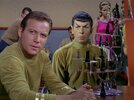 IMG_5697.jpeg387.3 KB · Views: 130
IMG_5697.jpeg387.3 KB · Views: 130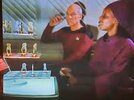 IMG_6358.jpeg16.6 KB · Views: 122
IMG_6358.jpeg16.6 KB · Views: 122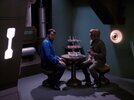 IMG_6359.jpeg257.5 KB · Views: 117
IMG_6359.jpeg257.5 KB · Views: 117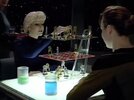 IMG_6357.jpeg22.3 KB · Views: 116
IMG_6357.jpeg22.3 KB · Views: 116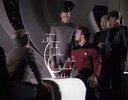 IMG_6352.jpeg29.5 KB · Views: 207
IMG_6352.jpeg29.5 KB · Views: 207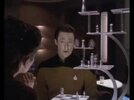 IMG_6353.jpeg22.8 KB · Views: 112
IMG_6353.jpeg22.8 KB · Views: 112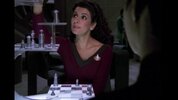 IMG_5703.jpeg116.3 KB · Views: 112
IMG_5703.jpeg116.3 KB · Views: 112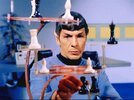 IMG_6356.jpeg72.8 KB · Views: 115
IMG_6356.jpeg72.8 KB · Views: 115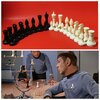 IMG_6354.jpeg109 KB · Views: 123
IMG_6354.jpeg109 KB · Views: 123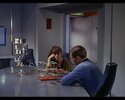 IMG_6360.jpeg54.9 KB · Views: 109
IMG_6360.jpeg54.9 KB · Views: 109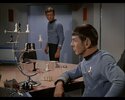 IMG_5696.jpeg59.5 KB · Views: 124
IMG_5696.jpeg59.5 KB · Views: 124
